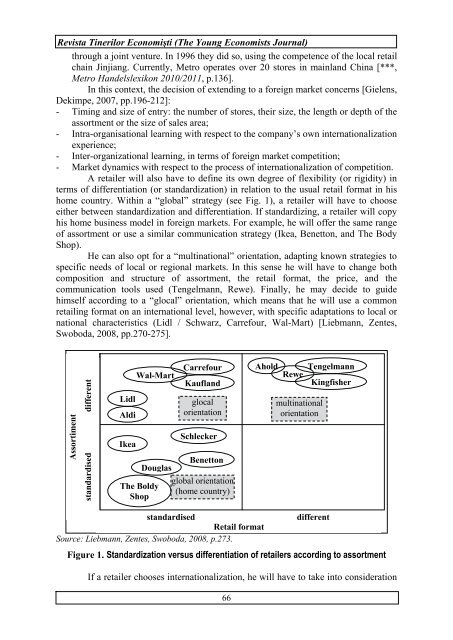Revista Tinerilor Economiºti (The Young Economists Journal)
Revista Tinerilor Economiºti (The Young Economists Journal)
Revista Tinerilor Economiºti (The Young Economists Journal)
You also want an ePaper? Increase the reach of your titles
YUMPU automatically turns print PDFs into web optimized ePapers that Google loves.
<strong>Revista</strong> <strong>Tinerilor</strong> Economişti (<strong>The</strong> <strong>Young</strong> <strong>Economists</strong> <strong>Journal</strong>)<br />
through a joint venture. In 1996 they did so, using the competence of the local retail<br />
chain Jinjiang. Currently, Metro operates over 20 stores in mainland China [***,<br />
Metro Handelslexikon 2010/2011, p.136].<br />
In this context, the decision of extending to a foreign market concerns [Gielens,<br />
Dekimpe, 2007, pp.196-212]:<br />
- Timing and size of entry: the number of stores, their size, the length or depth of the<br />
assortment or the size of sales area;<br />
- Intra-organisational learning with respect to the company’s own internationalization<br />
experience;<br />
- Inter-organizational learning, in terms of foreign market competition;<br />
- Market dynamics with respect to the process of internationalization of competition.<br />
A retailer will also have to define its own degree of flexibility (or rigidity) in<br />
terms of differentiation (or standardization) in relation to the usual retail format in his<br />
home country. Within a “global” strategy (see Fig. 1), a retailer will have to choose<br />
either between standardization and differentiation. If standardizing, a retailer will copy<br />
his home business model in foreign markets. For example, he will offer the same range<br />
of assortment or use a similar communication strategy (Ikea, Benetton, and <strong>The</strong> Body<br />
Shop).<br />
He can also opt for a “multinational” orientation, adapting known strategies to<br />
specific needs of local or regional markets. In this sense he will have to change both<br />
composition and structure of assortment, the retail format, the price, and the<br />
communication tools used (Tengelmann, Rewe). Finally, he may decide to guide<br />
himself according to a “glocal” orientation, which means that he will use a common<br />
retailing format on an international level, however, with specific adaptations to local or<br />
national characteristics (Lidl / Schwarz, Carrefour, Wal-Mart) [Liebmann, Zentes,<br />
Swoboda, 2008, pp.270-275].<br />
Assortiment<br />
different<br />
standardised<br />
Lidl<br />
Aldi<br />
Ikea<br />
Wal-Mart<br />
Douglas<br />
<strong>The</strong> Boldy<br />
Shop<br />
Carrefour<br />
Kaufland<br />
glocal<br />
orientation<br />
Schlecker<br />
Benetton<br />
global orientation<br />
(home country)<br />
standardised different<br />
Retail format<br />
Source: Liebmann, Zentes, Swoboda, 2008, p.273.<br />
Figure 1. Standardization versus differentiation of retailers according to assortment<br />
If a retailer chooses internationalization, he will have to take into consideration<br />
66<br />
Ahold<br />
Rewe<br />
multinational<br />
orientation<br />
Tengelmann<br />
Kingfisher















